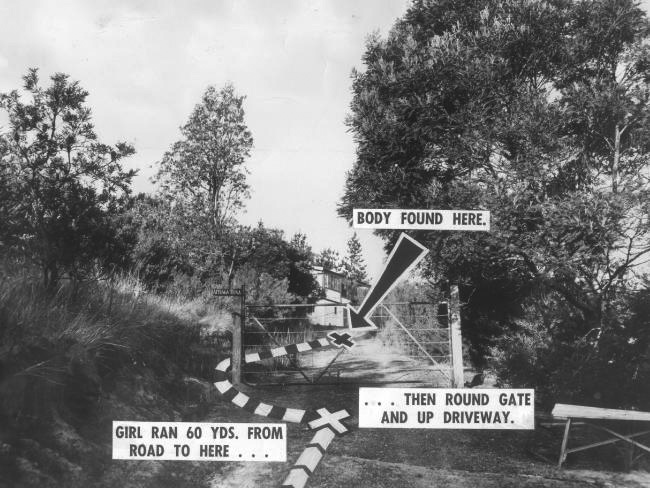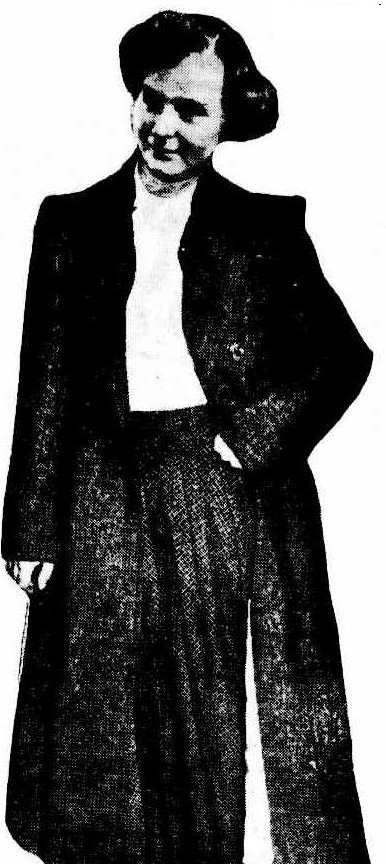 Homicide detectives who investigated the murder of 14-year-old Shirley May Collins, whose battered body was found in September 1953 at Mt Martha, described the murder as “one of the most vicious and sadistic in the history of Victoria”.
Homicide detectives who investigated the murder of 14-year-old Shirley May Collins, whose battered body was found in September 1953 at Mt Martha, described the murder as “one of the most vicious and sadistic in the history of Victoria”.
The investigation was said to be one of the biggest and most intensive manhunts in the history of Australian crime.
Shirley Collins was described as a young, shy, smiling and innocent girl. Her father had died and her mother remarried and moved to Queensland. She was one of four foster children living with her foster parents, Mr and Mrs A E Collins.
Shirley left her Reservoir home at 7.15pm on Saturday 12 September to go to a teenagers’ party in Richmond and had promised her foster mother she would return home early.
The party was at the home of a young workmate; guests were mostly teenage members of Coles staff where Shirley worked.
Ron Holmes, 21, of Chelsea, had arranged to meet her at Richmond station at 8pm. Holmes waited for nearly an hour and then went to the party alone.
Mrs Collins sensed something was wrong when her daughter did not return home by midnight.
Early Sunday morning, Mrs Collins took her worries to a policeman who lived nearby. The constable dismissed the mother’s fears, saying Shirley must have missed the last train and was probably sleeping at a girlfriend’s place and would be home in the morning. But eight hours later he referred Mrs Collins to the CIB.
Police received information that a girl answering Shirley’s description, and who they were almost certain was Shirley, was seen getting into a car near Regent CHK station only a few minutes before she was to have boarded a bus to take her to the city. Police believed the girl accepted a lift, expecting to be taken to her destination at Richmond, but instead was driven to Mt Martha.
A large squad of CIB detectives and police worked 24 hour days in an endeavour to locate the murder scene. They searched the Mt Martha and Dromana areas, questioning people who may have been able to provide clues.
At least five people saw Shirley’s body without realising she was dead; they presumed it was a girl sunbaking.
People told police they had seen Shirley and a well-spoken young man in Mornington on Saturday and Sunday nights. She was seen with the man at a hotel on Saturday night.
Mr Allan Downs, the licensee of Mornington’s Grand Hotel, recognised Shirley’s photo as soon as it was shown to him by the police.
Downs told police, “Shirley walked into the hotel lounge with a man about 26 to 30 soon after 8.30pm. I noticed them particularly because the lounge was empty, which is unusual on a Saturday night. I asked them if they were bona fide travellers and they said ‘Yes’ and sat down at a table a few feet from us.

“They had one glass of beer each; then they got up and left at about 8.50pm. This drew my attention because it is unusual for anyone to have just one glass of beer on a Saturday night. Although I did not notice the pair laughing or joking, they seemed quite friendly.
“As the girl left the lounge, she turned her head and smiled and said ‘Goodnight. Thank you very much’. The girl could have passed for an adult for her hair was done differently to the photo, but I feel sure it was her.”
Shirley Collins was then seen at a cafe in Mornington on the Sunday night. An employee of the cafe, Mrs Larkins, recognised a photograph of Shirley. She said, “The girl was with a youth aged about 18, with a long, pointed nose, brushed back hair, and of medium build”.
In the early morning of Monday 14 September, the body of Shirley Collins was discovered at Mt Martha by Lionel Liardit.
The 73-year-old man told police that his fox terrier, Bombo, had drawn his attention to the body. “I was walking along Marine Drive to pick up my mail,” he said. “Bombo was chasing rabbits and wallabies then ran into the grounds of the house and came back barking and tugging the cuff of my trousers. I wasn’t in any hurry and Bombo’s a pretty intelligent dog so I went to see what was worrying him. I saw the body.”
Liardit was shaken by the horror of his discovery.
Later medical examination showed Shirley had been dead for 10 to 12 hours.

Police believed the three broken beer bottles found near her battered body were the cause of her death. She had been the victim of a brutal attack.
A bottle, heavy with beer, had been smashed on her head and knocked her unconscious. Two other bottles, tops still firmly clamped, had been shattered against the back of her head.
The pretty face of Shirley Collins had been completely destroyed by blocks of cement. Her nose, jaw, cheekbones and forehead were broken.
Her clothes had been ripped from her body and thrown in trees and scrub. A stocking, still fastened to a suspender belt, was found on a tree stump.
Evidence at the murder scene indicated the man who killed her was shrewd and dangerous, and had given police few clues to his identity. Detectives ruled out the theory that Shirley had been abducted and taken to Mornington Peninsula by force. They believed the car used was stolen and later abandoned.
Days later, a shoe was found suspended about 1.5 metres off the ground on the branch of a tree about 10 metres from the scene of the murder. Inspector F Hobley, Chief of the Scientific Bureau, found the missing shoe by chance. He brushed aside a bush to get past, and the shoe fell to the ground.
Officers involved in the investigation were puzzled to explain why dozens of police and civilians who searched the murder scene on previous days did not find the shoe. They thought the shoe may have been brought back to the murder scene.
Police were anxious to interview a young man over the brutal slaying of Shirley Collins.
Inspector Donnelly, who was in charge of the investigations, said, “The man may be able to assist us greatly”.
Police believed the man and a young girl called at Mr Hubbard’s store in Tyabb about 9.30pm on the night of Shirley’s death. They were seen travelling in a dark coloured sedan perhaps a 1940 model Vauxhall.
Inspector Donnelly said, “At about 11.45 on the same night, a light coloured sedan of Vauxhall, Vanguard or Holden size with a chrome radiator and fittings was seen parked at the side of the roadway in Marine Drive, near Safety Beach, about a quarter of a mile from where Shirley’s body was found”.
Police believed a man and a woman had been in the car for some time. “There is little doubt that this couple saw something that would be of great assistance to the investigators,” Inspector Donnelly said.
He urged any person knowing the identity of the couple to come forward.
A radio broadcast of the possible events leading to Shirley Collins death was the first made in Victorian crime history and was similar to one broadcast in Sydney in 1952.
“We are hoping that the radio dramatisation will yield just one small point that will enable us to unravel the mystery,” Inspector Donnelly said.
“I am still certain that someone in Melbourne can supply the missing link. We have questioned so many criminals, perverts and suspects that our field will narrow quickly as soon as we get the link.”
Australia-wide interest was focused on the inquest into the murder of Shirley Collins, conducted by Coroner J R Burke after a 14-month search for her killer.
On Wednesday 20 October 1954, 14 witnesses gave evidence at the Melbourne Coroner’s Court.
A young married woman, who arrived under police escort with her head covered by a hood, gave evidence at the inquest.
Mr Burke ordered that the woman’s name should not be published and that she be referred to as “Mrs X”.
The woman, a “New Australian”, said she saw Shirley Collins talking to a man aged between 40 and 45 in a car at Richmond on the night she was killed. She had identified the girl from pictures in newspapers and other photographs.
After the 14 witnesses had given evidence, Mr Burke found that the girl was murdered by an unknown person and had a terrifying experience.
“She was an innocent victim of a murderer; her body was shockingly mutilated. How she was lured to the scene remains a mystery. It is regrettable that efforts by the police to trace the fiend responsible for his revolting crime have so far not met with success,” Mr Burke said.

Inspector Donnelly, who assisted the coroner, said later that the case was not closed and investigations had been carried out even in the past 24 hours.
Another police interview was conducted in Bairnsdale on Saturday 6 November when Detective Sergeant F Adam and Detective Kevin McMahon of Russell Street Homicide Squad interviewed a middle-aged man who had lived at East Melbourne near where Shirley Collins was last seen alive, but had left the area about the time of her death.
The detectives returned to Melbourne and stated it had not taken them any closer to solving the case.
A year later, a 37-year-old man “confessed” to police that he had murdered Shirley at Mt Martha.
The man told police he knew Shirley for at least two years before she died. He was a close friend of Shirley’s mother.
He insisted several times that on the night of 12 September, he drove Shirley to Mt Martha and killed her because they had argued throughout that night.
Detectives questioned him for three and a half hours but after he failed to reconstruct his movements and draw diagrams of the area where Shirley’s body was found, they released him.
Inspector Donnelly, who led the interrogation, said, “The man was the first who had confessed to having killed Shirley, but this is the first time anyone has tried hard to convince us that he was the killer”.
Inspector Donnelly said he and Senior Detective Noel Wilby, of the homicide squad, were convinced the man was innocent.
“Although it was nearly a year since Shirley was killed, there is no reason to suppose that the murderer will not be found. We are still quite hopeful.”
The murder of Shirley May Collins was Victoria’s most publicised and most baffling crime of the era.
Hundreds of people watched in sorrow as Shirley was buried at Preston Cemetery on 18 September 1953. The funeral service was conducted by Reverend J Sharman who said, “The man who killed her will be ultimately brought to judgement for his crime against society”.
Police teams interviewed more than 4000 people without finding a vital clue to identify the murderer. At times they had strong suspects, but none of them proved to be the killer.
Newspapers headlined the story for months and the murder is still unsolved to this day.
Did a killer confess?
In the mid 2000’s, a man reportedly admitted to murdering Shirley Collins in a death-bed confession. He also claimed to have murdered another woman, Elizabeth Maureen Williams, a 20-year-old typist, at Albert Park beach in 1949.
Although the murders were four years apart, it is believed details provided meant that police believed the confession credible.
Although nobody was ever charged with the murder of Shirley Collins, another man was charged with the murder of Elizabeth Williams.
John Bryan Kerr was found guilty of the murder, and sentenced to hang. His death sentence was later commuted to 20 years imprisonment. Once released, he lived under a new identity. He married, had two children and lived out his life as a free man. Until his dying day, he maintained his innocence in the killing of Elizabeth Williams.





